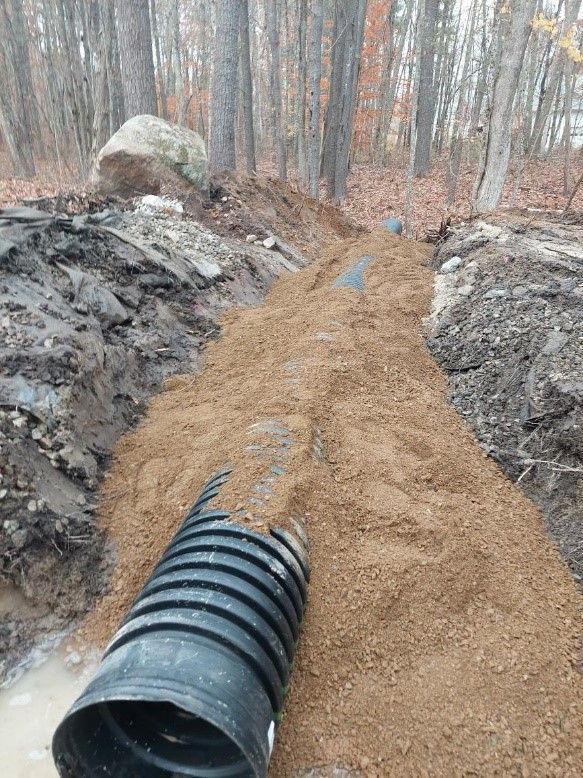Quality Road Construction for Long-Lasting Roads
Quality Road Construction for Long-Lasting Roads
Blog Article
Culvert Installation Facilitated: Step-by-Step Guide for Success
Setting up culverts may feel like a straightforward job, however guaranteeing an effective result needs careful preparation and implementation. From selecting the suitable culvert size to integrating correct drain steps, each step in the installment procedure plays an important role in the functionality and longevity of the culvert system. By following a methodical strategy and taking note of essential information, the installation can proceed efficiently, lessening potential problems down the line. Keep tuned to uncover the essential actions and considerations that can make culvert installment a smooth and successful endeavor.
Choosing the Right Culvert Size
Choosing the ideal culvert size is critical for guaranteeing reliable water flow and architectural honesty in culvert installation jobs - Pad Construction. The dimension of the culvert directly affects the circulation ability of water through the structure. A culvert that is also small can result in flooding and overflow, while one that is also big might result in reduced water rate, possibly creating debris build-up and blockages
To figure out the appropriate culvert size, variables such as the watershed location, optimal flow rates, and hydraulic effectiveness requirement to be carefully considered. Calculations based on these specifications aid in picking a size that can appropriately handle the expected water volume while decreasing the threat of blockages and structural failure.
It is important to get in touch with engineering standards and requirements to make certain that the picked culvert dimension fulfills the project demands and local policies (Pad Construction). By selecting the best culvert size, task managers can maximize water circulation, stop possible problems, and improve the overall effectiveness and durability of the culvert setup
Preparing the Setup Site
Efficient culvert installment requires meticulous preparation of the installment site to ensure ideal structural support and capability. Prior to commencing the installment process, it is critical to remove the site of any particles, vegetation, or obstructions that can hamper the culvert's positioning.
In addition, it is necessary to think about aspects such as dirt composition, groundwater levels, and ecological influences when preparing the installment website. Conducting a complete site evaluation can assist recognize any kind of possible challenges or threats that might useful content influence the culvert's efficiency. By putting in the time to prepare the setup website correctly, you can help guarantee a successful culvert installation that meets architectural demands and makes sure lasting capability.
Positioning the Culvert Properly

The quality at you can check here which the culvert is positioned is crucial for maintaining an appropriate slope for water circulation. Additionally, the culvert ought to be oriented properly to make sure that the inlet and electrical outlet are in the correct areas. Pad Construction.
Backfilling and Compacting the Dirt
Proper backfilling and compaction of the dirt around the culvert is essential to make sure security and stop prospective problems in the future. When the culvert is properly placed, the next vital action is to backfill the location around it with appropriate material.
Compaction aids in decreasing the opportunities of settlement and ensures uniform assistance around the culvert. It is essential to small the soil evenly on all sides of the culvert to maintain its architectural integrity.
Appropriate backfilling and compaction not only supply security to the culvert however additionally help in preventing dirt disintegration and maintaining the durability of the culvert system.
Making Sure Correct Water Drainage Integration
Incorporating reliable drain services plays a critical function in the overall functionality and longevity of culvert installments. Correct drainage assimilation is necessary for handling water flow, protecting against disintegration, and making sure the structural stability of the culvert system. To achieve this, it is vital to develop a comprehensive water drainage strategy that considers factors such as the quantity of water expected, the topography of the location, and the type of dirt present.

Additionally, integrating features like disintegration control steps, such as riprap or greenery, can further enhance the effectiveness of the drain system. By very carefully planning and applying these drain options, culvert installments can function effectively and endure the test of time.
Verdict
In click over here now conclusion, proper culvert installment is critical for keeping efficient drain systems. By selecting the appropriate culvert size, preparing the installation website, positioning the culvert properly, backfilling and compacting the soil, and making sure proper drain combination, success can be attained. Complying with these actions will certainly aid make sure the durability and effectiveness of the culvert, eventually adding to the general success of the drain system.
Report this page